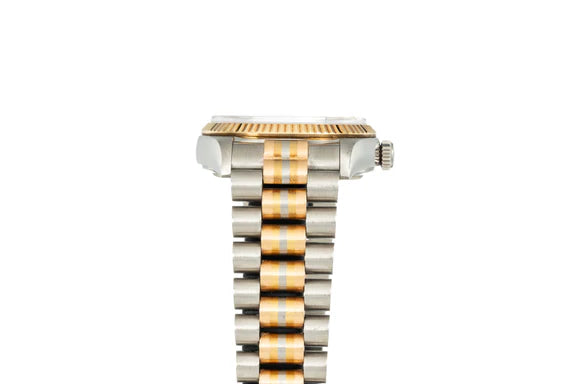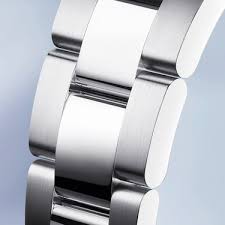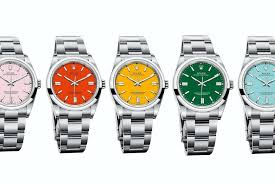
Rolex: Exceptional Materials Make Timeless Watches
Rolex watches are renowned for their precision, durability, and luxury. Central to their excellence are the high-quality materials used in their manufacture. Let's delve into the materials that make Rolex watches exceptional and explore their origins.
Stainless Steel: The Backbone of Durability
Rolex predominantly uses Oystersteel, a high-grade 904L stainless steel. Known for its exceptional corrosion resistance and brilliant shine, Oystersteel is sourced from Böhler Edelstahl in Kapfenberg, Austria. This steel is meticulously crafted into the cases and bracelets of iconic models like the Daytona, Submariner, and Explorer.
Gold and Platinum: The Epitome of Luxury

Rolex employs its own foundry to create exclusive gold alloys. The use of 18k yellow, white, and Everose gold ensures unmatched quality and color consistency. Platinum, another precious metal, is utilized in the most prestigious models. These materials are sourced from top-tier suppliers to maintain Rolex’s stringent standards.
Everose Gold
Introduced in 2005, Everose gold is an exclusive 18 kt pink gold alloy with a unique color. Developed by Rolex experts, it contains at least 75% gold, 20% copper, as well as palladium and indium, ensuring exceptional radiance and resistance.
18 kt Yellow Gold

Rolex's 18 kt yellow gold is crafted exclusively in their own foundry located at the Plan-Les-Ouates site in Geneva. This integration of a complex industrial process ensures the highest standards of quality and uniqueness in their yellow gold watches.
Cerachrom: Unfading Beauty

Anyone who has ever owned a watch and worn it extensively knows that the bezel is often the most exposed part to external impacts, scratches, and corrosion. To address this, Rolex developed and patented the Cerachrom bezel. This particularly hard, corrosion-resistant ceramic is virtually scratch-proof, with only diamonds being able to scratch it.
In 2016, Rolex introduced the first monobloc Cerachrom bezel in the Oyster Perpetual Cosmograph Daytona, moving from ceramic inserts inside metal bezels to a single piece of Cerachrom. The basic ceramic material is a very fine zirconium dioxide or aluminum oxide powder, mixed with a binding agent and pigments for the final color.
The manufacturing process includes high-pressure molding, eliminating the binding agent, and exposing the material to 1,600°C heat. This results in remarkable surface hardness, sheen, and color. Each piece contracts by about 25% during this process and requires precision machining for the ultimate fit and finish.
For the iconic GMT-Master II line, the two-color Cerachrom bezel is achieved by impregnating half of the insert with chemical compounds that react during the sintering process to create distinct colors. The bezels also feature gold or platinum PVD-coated numerals and graduations, adding to their luxurious appeal.
Sapphire Crystal: Unscratchable and Clear

Rolex uses synthetic sapphire crystal for its watch faces, providing superior scratch resistance and clarity. This ensures that the dial remains visible and pristine, regardless of wear and tear.
High-Performance Elastomer: Comfort and Flexibility
For models like the Yacht-Master, Rolex developed an elastomer known as Oysterflex. This material combines the robustness of metal with the flexibility and comfort of rubber, ensuring a perfect fit for the wearer.
Proprietary Alloys and Exclusive Materials
Rolex's in-house foundry plays a pivotal role in the innovation and creation of its materials. This facility allows Rolex to produce proprietary alloys such as Rolesor (a combination of Oystersteel and gold) and Rolesium (a blend of Oystersteel and platinum), ensuring complete control over the quality and consistency of the materials used in its watches.
Sustainable Sourcing and Production
Rolex is committed to sustainable practices in sourcing and production. The company’s dedication to environmental responsibility includes using recycled gold and steel in its watches and ensuring that its supply chain adheres to the highest ethical standards.
How the Metals Are Made

Rolex set up its own state-of-the-art foundry to cast its gold, allowing the company to consistently ensure the superlative quality of its most precious materials. The foundry, located just outside Geneva, is where some of the most exactingly cast gold in watchmaking is made.
The work of a foundryman is both physically and mentally demanding. Pure 24 ct gold is too malleable for daily use, so it must be alloyed to make 18 ct gold, which Rolex exclusively uses. The process begins by pouring the liquid metals into a graphite crucible in quantities so precise they are measured to within one-tenth of a gram. Once in the crucible, the metals are heated to over 1,150 degrees Celsius and continuously torched to prevent oxidation. The liquid metals form droplets that fall into a vat of cool water, creating beads of 18 ct gold. These beads are dried, inspected for flaws, and sampled to verify their composition and fineness.

Next, a second fusion takes place in a continuous casting machine, where the beads are melted and cast through a water-cooled die into the required shapes. Slabs are made for middle cases and case backs, bars for bracelet links, and rods for bezels. The foundryman ensures the gold solidifies at the correct rate, with precise temperature control to avoid ruining the casting. The castings are then inspected for quality before being sent to their respective metal-forming workshops.
Having complete control over the casting process allows Rolex to formulate its own gold alloys. Rolex's white gold is mixed with a small percentage of palladium, maintaining a lustrous, silvery white sheen without needing a rhodium coating. Everose, Rolex's own 18 ct pink gold introduced in 2005, consists of gold, copper, and platinum, ensuring a pink hue that never fades.
Breakdown of Key Rolex Materials
Oystersteel: Known for its superior corrosion resistance and brilliant finish, used in watch cases and bracelets.
18k Gold: Rolex's proprietary yellow, white, and Everose gold alloys ensure unmatched quality and color consistency.
Platinum: Used in prestigious models for its rarity and luster.
Cerachrom: A unique ceramic material used for bezels, known for its durability and resistance to fading.
Sapphire Crystal: Synthetic sapphire provides scratch resistance and clarity for watch faces.
Oysterflex: A high-performance elastomer used in select models for a combination of robustness and comfort.
Leather Straps: High-quality leather sourced from Hirsch, adding elegance to certain models.
Conclusion
The meticulous selection and in-house production of materials set Rolex apart in the luxury watch industry. From the stainless steel sourced in Austria to the proprietary gold and platinum alloys, each element contributes to the unparalleled quality of a Rolex watch. This commitment to excellence ensures that every Rolex timepiece is a masterpiece of durability, precision, and timeless beauty.
By focusing on these unique materials and the meticulous processes involved in their production, Rolex not only maintains its reputation for quality but also continues to lead the industry in innovation and sustainability.



